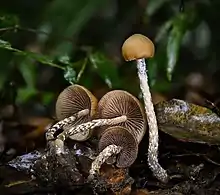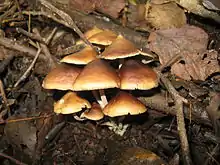| Psilocybe zapotecorum | |
|---|---|
 | |
| Scientific classification | |
| Domain: | Eukaryota |
| Kingdom: | Fungi |
| Division: | Basidiomycota |
| Class: | Agaricomycetes |
| Order: | Agaricales |
| Family: | Hymenogastraceae |
| Genus: | Psilocybe |
| Species: | P. zapotecorum |
| Binomial name | |
| Psilocybe zapotecorum Heim emend Guzman | |
| Synonyms[1] | |
|
Psilocybe candidipes Singer & A.H. Sm. (1958) | |
| Psilocybe zapotecorum | |
|---|---|
| Gills on hymenium | |
| Cap is conical or convex | |
| Hymenium is adnate or sinuate | |
| Stipe is bare | |
| Spore print is purple-brown | |
| Ecology is saprotrophic | |
| Edibility is psychoactive | |
Psilocybe zapotecorum is a psilocybin mushroom which has psilocybin and psilocin as main active compounds. It is in the section Zapotecorum.[1][2]
Etymology and history
It is named for the Zapotec Indians, who are native to the Sierra Madre mountains of Oaxaca Mexico, as well as the area they inhabited. According to Richard E. Schultes the Zapotec name translates as "Crown of thorns mushroom".[3] Other sources give the Zapotec name as badao zoo translated as "hongo borracho", "drunken mushroom".[4]
- 1956: Holotype collected August 4, 1956 in Santiago Yaitepec by Roger Heim and R. Gordon Wasson.[5]
- 1957: Roger Heim and R. Gordon Wasson describe Magic Mushrooms with illustrations in "Magic Mushrooms" LIFE Magazine May 13, 1957.
- 1958-9: Roger Heim published the first scientific description of this fungus. Albert Hofmann also finds Psilocybin.
- 1963: Roger Heim describes this mushroom in the work "Les Champignons Toxiques et Hallucinogènes."
- 1976: Jonathan Ott and Gaston Guzman publish again about the fungus, but describe it as Psilocybe candidipes.
Description
Psilocybe zapotecorum has a farinaceous and raphanoid smell and taste.
Cap
The cap is 2–13 cm, conical to convex, and very rarely expanding to plane in age. The margin wavy sometimes with an acute papilla or mamilla, usually umbonate or with a depressed center. In young specimens the margin has a scalloped edge which sometimes curls upwards as the mushroom matures. The cap is yellowish brown to tan, fading to cream-yellow then brown and finally black through age. The flesh is originally white but soon changes to a cyan blue, then quickly to black.
Gills
Psilocybe zapotecorum gills are a cream color when young and violet brown in age, with an attachment that is sinuate or adnate, and sometimes subdecurrent.
Spores
The spores are dark violet brown, oblong to subellipsoid to subrhomboid, and thin-walled with a short apiculus and truncate germ pore. They measure (5) 6 - 7 (-8) by (3-) 3.5 - 4.5 (-5) x 3 - 4 µm.[1]
Stipe
The stipe is 3–26 cm long, and 0.5–1 cm thick. It is central, flexuous, cylindric or slightly flattened, and hollow. It can be white to grey, turning yellowish, blue, and black in age. The entire stem is covered with many white scales which are more pronounced in the lower part of the stipe. The partial veil is white and arachnoid, disappearing in age. Often a long pseudorrhiza can be found attached the base of the stipe. Strongly bruising blue then black where damaged.
Distribution and habitat
Psilocybe zapotecorum grows solitarily or gregariously, sometimes in cespitose clusters of around a 50 mushrooms. It is found near rivers, creeks and ravines, sometimes growing directly from steep mossy ravine walls. Psilocybe zapotecorum is also found in humid and shadowed places in mesophytic forests, oak-and-pine forests, or cloud forests.
Psilocybe zapotecorum is often found in subtropical forests containing Alnus sp., Magnolia sp., Fraxinus sp., Quercus sp., large pines, and blackberry bushes.
Psilocybe zapotecorum grows in Argentina, Brazil, Chile, Colombia, Mexico, Peru, Guatemala, El Salvador, Venezuela, Nicaragua and Ecuador.[1]
Gallery
 Psilocybe zapotecorum
Psilocybe zapotecorum Psilocybe zapotecorum
Psilocybe zapotecorum Psilocybe zapotecorum
Psilocybe zapotecorum Psilocybe zapotecorum
Psilocybe zapotecorum Psilocybe zapotecorum
Psilocybe zapotecorum Psilocybe zapotecorum
Psilocybe zapotecorum Psilocybe zapotecorum
Psilocybe zapotecorum Psilocybe zapotecorum
Psilocybe zapotecorum Psilocybe zapotecorum lamellar trama 1000x
Psilocybe zapotecorum lamellar trama 1000x Psilocybe zapotecorum gill edge 1000x
Psilocybe zapotecorum gill edge 1000x Psilocybe zapotecorum spores 1000x
Psilocybe zapotecorum spores 1000x
References
- 1 2 3 4 Guzmán, Gastón (2012). "New Taxonomical and Ethnomycological Observations on Psilocybe S.S. From Mexico, Africa and Spain" (PDF). Acta Botanica Mexicana. 100: 79–106. doi:10.21829/abm100.2012.32.
- ↑ Ramírez-Cruz, Virginia; Guzmán, Gastón; Villalobos-Arámbula, Alma Rosa; Rodríguez, Aarón; Matheny, Brandon; Sánchez-García, Marisol; Guzmán-Dávalos, Laura (2013). "Phylogenetic inference and trait evolution of the psychedelic mushroom genus Psilocybe sensu lato (Agaricales)". Botany. 91 (9): 573–591. doi:10.1139/cjb-2013-0070.
- ↑ Schultes, Richard Evans (1993). "The Botanical Sources of New World Narcotics". In Leary, Timothy; Metzner, Ralph; Weil, Gunther M. (eds.). The Psychedelic Reader: Classic Selections from the Psychedelic Review. Citadel Press. p. 100. ISBN 978-0-8065-1451-2.
- ↑ Orijel, Roberto Garibay (2009). "Los nombres zapotecos de los hongos". Revista Mexicana de Micología Versión Impresa. 30. ISSN 0187-3180.
- ↑ "Observation 155661: Psilocybe zapotecorum R. Heim". mushroomobserver.org. Retrieved 2022-12-08.